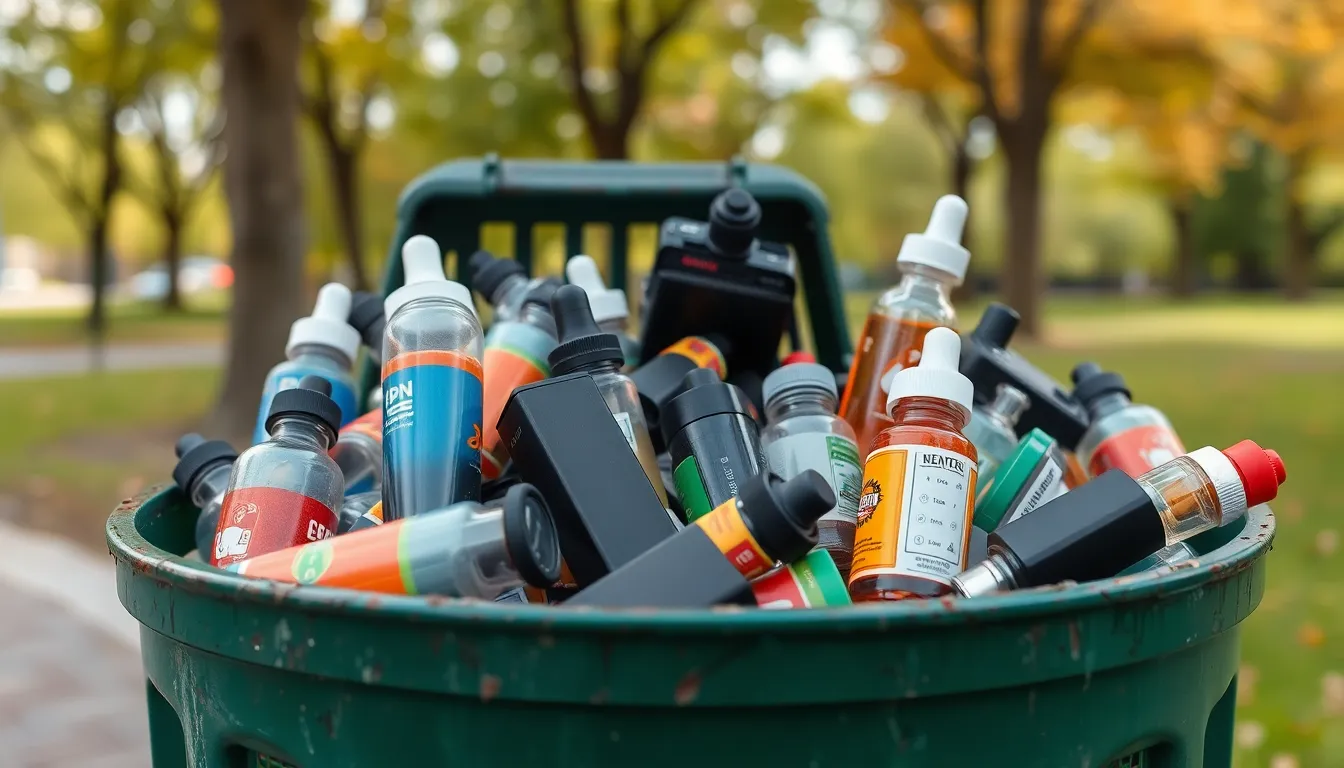As vaping continues to rise in popularity, the question of how to dispose of vapes responsibly becomes increasingly important. Many users enjoy the convenience and variety that vape devices offer, but improper disposal can lead to significant environmental issues. Knowing the best practices for disposing of these devices not only helps protect the planet but also ensures compliance with local regulations.
Vape devices contain batteries and other materials that can be harmful if not handled correctly. With the right information, anyone can learn how to dispose of vapes safely and effectively. This guide will outline the essential steps for proper disposal, making it easier for users to make environmentally conscious choices.
Table of Contents
ToggleUnderstanding Vapes and Their Components
Vapes, also known as electronic cigarettes or e-cigarettes, have risen in popularity as alternatives to traditional smoking. Understanding their components is essential for proper disposal.
What Is a Vape?
A vape is an electronic device that vaporizes liquid for inhalation. Vapes deliver nicotine, flavorings, and other chemicals through a heated coil, converting e-liquid into vapor. Users experience nicotine similar to traditional smoking, but with varying levels of harmful chemicals.
Common Components of Vapes
- Battery: Supplies power to the device, often lithium-ion due to its efficiency and rechargeability.
- Atomizer: Heats the e-liquid, turning it into vapor. The atomizer contains the heating coil and wicking material.
- Cartridge or Tank: Holds the e-liquid, which comes in various flavors and nicotine concentrations.
- Mouthpiece: The end of the device where users inhale vapor. It’s typically made of plastic or silicone.
- Charger: Used to recharge the vape battery, often connected via a USB port.
Each component plays a role in the overall function of vapes, impacting their performance and the user’s experience. Understanding these parts helps users make informed decisions regarding disposal methods.
Importance of Proper Disposal

Proper disposal of vapes plays a crucial role in minimizing environmental and health risks. Vaping devices contain materials that can harm ecosystems and human health when not disposed of correctly.
Environmental Impact
Vape devices contribute to electronic waste, comprising harmful substances like lithium-ion batteries and plastics. These components can leach toxic materials into soil and water sources, affecting wildlife and natural habitats. In 2022, e-waste accounted for 53.6 million metric tons globally, with improper disposal amplifying the crisis. Responsible disposal practices, including recycling and following local regulations, significantly mitigate these environmental impacts.
Health Hazards
Improper disposal of vapes poses immediate health risks. Batteries can explode or catch fire when discarded improperly, inflicting injury or property damage. Additionally, discarded vape liquids can contain hazardous chemicals, endangering both public health and the environment. In 2020, the National Poison Data System reported over 10,000 exposures to e-cigarette products, highlighting the dangers associated with improper disposal. Safe disposal methods help prevent these hazards, safeguarding both communities and ecosystems.
How to Dispose of Vapes
Responsible disposal of vapes requires understanding both recycling options and safe disposal methods. Users play a crucial role in minimizing environmental impacts by following appropriate practices.
Recycling Options
Many vape devices contain recyclable materials, particularly metals and plastics. Users can check local recycling programs to find facilities that accept electronic waste, including vapes. Some manufacturers also offer take-back programs, allowing users to return old devices for proper recycling. Additionally, organizations like Call2Recycle provide resources for safely recycling batteries found in vape devices.
Safe Disposal Methods
Safe disposal methods prevent environmental contamination and health hazards. Users should first remove the battery from the device whenever possible, as batteries pose significant risks if discarded improperly. For the remaining components, users should follow these steps:
- Follow local regulations: Verify disposal guidelines from city or county waste management authorities.
- Use designated e-waste bins: Place devices in e-waste bins available at specific collection points.
- Contact hazardous waste facilities: If unsure about the disposal process, users can consult hazardous waste facilities for guidance.
- Avoid landfills: Never dispose of vapes in regular trash, as this contributes to environmental harm.
Adhering to these methods ensures safer disposal and promotes community health and environmental protection.
Regulations and Guidelines
Understanding regulations and guidelines for vape disposal ensures proper compliance and environmental protection. Adhering to both local and national directives contributes to responsible waste management.
Local Regulations
Local regulations vary widely based on municipality and state laws. Many jurisdictions classify vapes as electronic waste, requiring specific disposal methods. Users should contact their local waste management department for detailed information on accepted practices. Some areas offer dedicated e-waste drop-off locations or periodic e-waste collection events. Checking local ordinances helps users identify the specific disposal requirements, including whether disassembly or battery removal is necessary before disposal.
National Guidelines
National guidelines provide a framework for electronic waste disposal, including vapes. The Environmental Protection Agency (EPA) outlines recommendations for handling e-waste safely. Vapes are subject to the Resource Conservation and Recovery Act (RCRA), which governs hazardous waste management. Users must ensure that vape devices are disposed of in a way that aligns with federal laws. Additionally, the Consumer Product Safety Commission (CPSC) provides safety information regarding battery disposal, emphasizing the importance of recycling batteries to prevent potential hazards. Following these national guidelines reinforces safe environmental practices while reducing ecological impact.
Responsible disposal of vapes is essential for protecting the environment and public health. By understanding the components of these devices and following proper disposal methods, users can significantly reduce the risks associated with electronic waste. Engaging with local recycling programs and adhering to regulations ensures that vapes are disposed of safely and effectively.
Making informed choices about vape disposal not only helps in minimizing ecological impact but also promotes a healthier community. As vaping continues to grow in popularity, being proactive about disposal practices becomes increasingly important for everyone.




